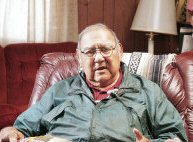
Kiowa Elder Tells Tribal
History Through Song

Evans Ray Satepauhoodle
Photo by David McDaniel
By Judy Gibbs Robinson
Staff Writer
HOMINY — After knee surgery and a bad fall, Evans Ray Satepauhoodle has
trouble getting out of his recliner. When he does, he leans heavily on a cane.
But physical infirmities cannot keep the 74-year-old Kiowa
elder from a date he made with posterity. Several times a month, in the living
room of his small wood-frame home, he sings old American Indian songs into a
university professor’s digital tape recorder to preserve them for all
Oklahomans, not just Indians.
"This will help them better understand my people,” Satepauhoodle
said.
He adjusts his hearing aid when it begins to hum, clears his throat, closes
his eyes and sings in a voice that is steady but thinned by age. His fingers
keep time on a small deerskin drum in his lap.
The Kiowa words that rise and fall tell the story of the warrior Sitting Bear,
who refused to become a prisoner after being captured near Fort Sill. As U.S.
soldiers loaded the captive Indian into a wagon bound for prison, the warrior
announced that when he arrived at a certain elm tree, he would be dead. When
he reached the tree, he pulled out a knife and quickly was killed by a soldier
guarding the line.
"This is real. My grandma used to point out that elm tree to me every time
we went to the Indian hospital,” Satepauhoodle said.
Sometimes Hugh Foley, a professor at Rogers State University in Claremore, brings
a video camera along so future scholars will be able to see Satepauhoodle singing.
"All this stuff will wind up in the Oklahoma Historical Society archives
or the Museum of the American Indian or the new American Indian Cultural Center,”
Foley said.
Satepauhoodle learned thousands of songs as a child, stretched out near the
family’s wood stove at the end of the day while his father, a traditional
Kiowa, sang. "He’d be putting me to sleep, but those songs were going
in,” Satepauhoodle said.
Passing it along
Tribes like the Kiowa with no written language passed their history from generation
to generation through songs, so preserving the songs means preserving an Indian
version of history.
"One of the goals is to get as close as we can to the real Indian story,
told by an Indian — not by a USC graduate or Stanford or Princeton or
Columbia. We’re talking about someone down here, at home. That’s
why I’m in this thing until I take my last breath,” Satepauhoodle
said.
Between songs, he and Foley drink coffee and plan other preservation projects,
including a documentary of the Kiowa people’s migration from the Canadian
border to the Mexican border. A hand-drawn map, enlarged and laminated, shows
the route.
"There’s a song that goes with every place, so our idea is to show
each place,” said Foley, who teaches Native American studies, music history
and cinema.
The men met after Satepauhoodle saw one of his televised courses and invited
Foley to Hominy to talk.
"He sensed when we first started meeting here that I had some things that
were very invaluable. That’s why we clicked as soon as we met, and we’re
still clicking,” Satepauhoodle said. "I trust him and he trusts me.”
Since then, the pair has made a public service video in the Kiowa language about
Indians and diabetes risk, and they recently posted a clip of Satepauhoodle
singing in Kiowa on YouTube, the popular video-sharing site.
"I got another wild idea since I last talked to you,” Satepauhoodle
said as he greeted Foley last week.
A retired school teacher with a master’s degree, Satepauhoodle embraces
new technology as a way to reach a wider audience.
"It’s an educational vehicle, in the white man’s terms. When
I saw it, I want to hook on and I’m still hooking on,” he said.
Foley, a music historian who worked in radio for years, is the technical end
of the partnership and also its legs. Every Tuesday that Satepauhoodle is up
for it, Foley makes the 50-plus mile trip from his home in Stillwater to Hominy.
"I’m the catalyst, the conduit, but I’m not the source,”
said Foley, a sandy-haired white man who married a Creek woman and embraced
her culture. He does a weekly program of American Indian music on KSPI radio
in Stillwater.
When Satepauhoodle asked for his help two years ago, Foley said refusing never
crossed his mind.
"It just must be done. It’s important. It’s American history,”
he said. The partners also hope their projects will become models for other
tribes. "Each one of these 438 tribes, they’ve got their story, too.
And when they hear Evans Ray and old Hugh here, they’ll say, ‘Why
can’t we do that too? Why can’t we?’” Satepauhoodle
said.
Kiowa Flag Song, Evans Ray
Kiowa elder, Evans Ray Satepauhoodle, tells the history of the Kiowa Flag Song in Kiowa and English, sings it, and then says the words slowly in Kiowa. This is intended for Kiowas who are away from home or who have never had a chance to learn the Kiowa Flag Song
The history, culture and traditions of the Native American Kiowa are still alive and well. A little song about Kiowa
Web page, 4/29/2007